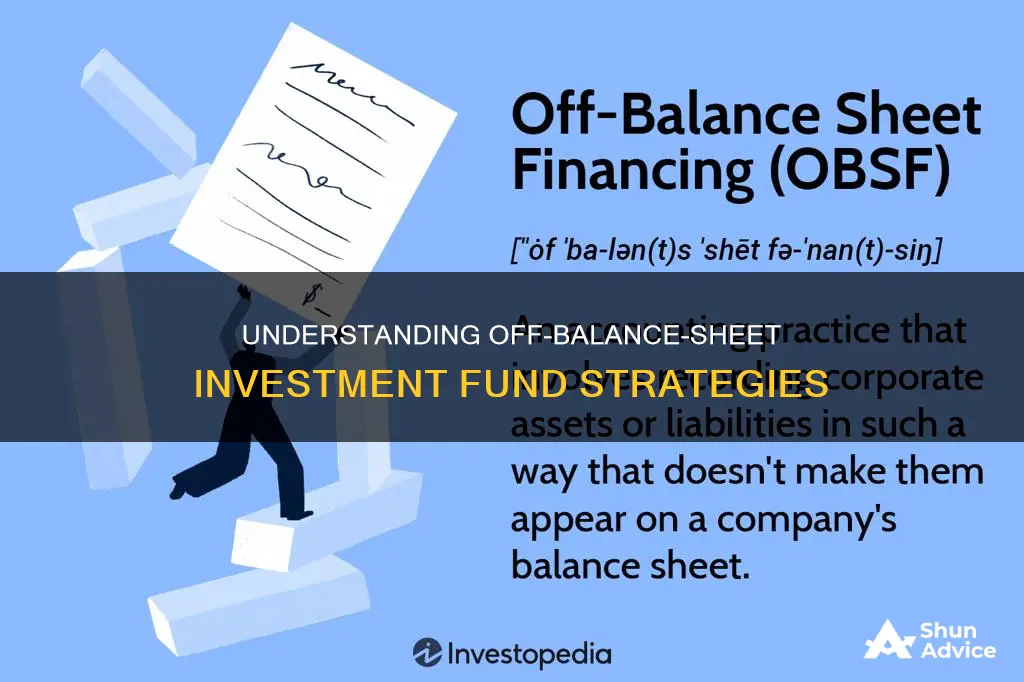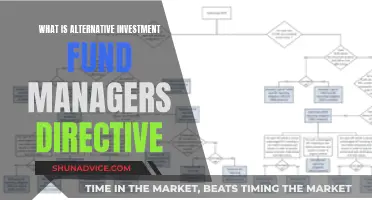
Off-balance-sheet financing is an accounting method that allows companies to record assets or liabilities in a way that prevents them from appearing on their balance sheet. This practice is used to keep debt-to-equity and leverage ratios low, facilitating cheaper borrowing and preventing bond covenants from being breached. Off-balance-sheet financing is a legitimate and permissible accounting method, as long as companies abide by established accounting rules and regulations. However, it has attracted scrutiny due to its potential for misuse, as seen in the case of Enron, where off-balance-sheet entities were used to hide debt and losses, presenting a misleading picture of financial health.
What You'll Learn

Off-balance-sheet financing (OBSF)
OBSF is often used to keep debt-to-equity and leverage ratios low, facilitating cheaper borrowing and preventing the breach of debt covenants. By excluding certain assets and liabilities from their balance sheets, companies can present a healthier financial picture, making themselves more attractive to investors.
OBSF methods include selling receivables, providing guarantees or letters of credit, participating in joint ventures, research and development partnerships, and operating leases. Operating leases, in particular, have been one of the most popular methods of OBSF. Instead of buying equipment or property outright, a company can rent or lease it and then purchase it at a minimal price at the end of the lease period. By recording only the rental cost as an operating expense, the company can keep its balance sheet liabilities low.
Another OBSF method is the use of partnerships. When a company creates a partnership, it is not required to disclose the partnership's liabilities on its balance sheet, even if it has a controlling interest. This allows the company to keep its financial statements clean and avoid disclosing potential risks to investors.
While OBSF can provide benefits to companies, it also carries risks. One of the main issues is the potential for misuse, as companies may try to hide losses or debts from their balance sheets, presenting a misleading picture of their financial health. This has led to increased regulatory scrutiny and demands for greater transparency in OBSF reporting.
To address these concerns, companies are required to follow Securities and Exchange Commission (SEC) and generally accepted accounting principles (GAAP) requirements by disclosing OBSF in the notes of their financial statements. However, investors need to carefully analyse these notes to fully understand the financial health of the company.
Young Investors: Mutual Funds for Long-Term Wealth
You may want to see also

On-balance-sheet vs off-balance-sheet
In accounting, "off-balance-sheet" (OBS) items refer to assets, debts, or financing activities that do not appear on a company's balance sheet. Although not recorded on the balance sheet, these items are still assets and liabilities of the company.
OBS items are often used to keep debt-to-equity (D/E) and leverage ratios low, facilitating cheaper borrowing and preventing bond covenants from being breached. For example, a company with a lot of debt may need to borrow more capital to fund its operations. By keeping its debt-to-equity ratio low, it can obtain better financing rates.
OBS items are typically those not owned by or that are not a direct obligation of the company. For instance, when loans are securitized and sold off as investments, the secured debt is often kept off the bank's books. Prior to a change in accounting rules, operating leases were one of the most common OBS items.
OBS items are not inherently deceptive, and certain businesses routinely keep substantial OBS items. For example, investment management firms are required to keep clients' investments and assets off-balance sheet. OBS items are also used to share the risks and benefits of assets and liabilities with other companies, as in joint venture (JV) projects.
However, the practice of OBS financing has come under increasing scrutiny after a number of accounting scandals, such as Enron, revealed the misuse of this practice to hide debt and losses.
On the other hand, "on-balance-sheet" items are those that appear on a company's balance sheet. In general, an item should appear on the company's balance sheet if it is an asset or liability that the company owns or is legally responsible for. Uncertain assets or liabilities must meet tests of being probable, measurable, and meaningful. For example, a company being sued for damages would not include the potential legal liability on its balance sheet until a judgment against it is likely and the amount can be estimated.
The distinction between on-balance-sheet and off-balance-sheet items can be quite detailed and depends to some degree on management judgments. Banks, for example, traditionally keep loans on their balance sheets and retain credit risk. However, securitization enables banks to remove loans from balance sheets and transfer the associated credit risk. Thus, securitized loans are represented off the balance sheet.
While OBS financing is a legal practice, it becomes illegal if used to hide assets or liabilities from investors and financial regulators. Companies must follow Securities and Exchange Commission (SEC) and generally accepted accounting principles (GAAP) requirements by disclosing OBS financing in the notes of their financial statements.
Unconstrained Bond Funds: Diversifying Your Investment Portfolio
You may want to see also

The legality of off-balance-sheet accounting
Off-balance-sheet financing (OBSF) is a legal practice as long as companies follow accounting rules and regulations. It is a type of accounting practice that involves recording corporate assets or liabilities in a way that doesn't make them appear on a company's balance sheet. While OBSF is not illegal, it has come under increasing scrutiny due to its potential for misuse in deceptive practices.
The legality of OBSF hinges on transparency and compliance with established accounting rules and regulations. Companies utilising OBSF must abide by the Generally Accepted Accounting Principles (GAAP) and disclose relevant information in the notes of their financial statements per the Securities and Exchange Commission (SEC) and GAAP requirements. OBSF becomes illegal when used to hide assets or liabilities from investors and financial regulators, as exemplified in the Enron scandal.
The distinction between on-balance-sheet and off-balance-sheet items can be nuanced and depend on management judgments. Generally, an item should appear on the company's balance sheet if it is an asset or liability owned by the company or one for which they are legally responsible. Uncertain assets or liabilities must meet tests of being probable, measurable, and meaningful.
While OBSF can be a legitimate strategy for managing debt-to-equity ratios and leverage ratios, it is essential for investors to carefully review financial statements and look for red flags to ensure they are making well-informed investment decisions.
Christians Investing in Mutual Funds: Is It Ethical?
You may want to see also

Examples of off-balance-sheet financing
Off-balance-sheet financing is a legal and legitimate practice as long as companies are transparent and follow accounting standards and regulations. However, it has come under scrutiny due to its potential for misuse.
- Operating Leases: This is one of the most common forms of off-balance-sheet financing. A company rents or leases equipment or property instead of buying it outright. They then have the option to purchase it at a minimal price at the end of the lease period. By choosing this option, the company only records the rental cost as an operating expense on its income statement, resulting in lower liabilities on its balance sheet.
- Joint Ventures (JV) and Research and Development (R&D) Partnerships: When a company creates a JV or R&D partnership, it does not have to disclose the partnership's liabilities on its balance sheet, even if it has a controlling interest in the entity. This allows the company to add minimal liability to its balance sheet while conducting research or other activities.
- Special Purpose Vehicles (SPVs) or Special Purpose Entities (SPEs): Companies may purchase small ownership positions in SPVs or SPEs, which have their own balance sheets. They can then place any questionable assets or liabilities on these separate balance sheets. SPVs or SPEs may have higher credit ratings than the sponsoring firms, allowing the company to receive cheaper financing.
- Leaseback Agreements: Under a leaseback agreement, a company sells an asset, such as property, to another entity and then leases it back from the new owner. The company only lists the rental expenses on its balance sheet, while the asset itself is listed on the balance sheet of the owning business.
- Accounts Receivables: Companies can sell accounts receivables (funds owed by customers) to another company, called a factor. The factor acquires the risk of default and pays the company a percentage of the total value upfront. Once customers have paid up, the factor pays the company the balance minus a fee. This allows the business to outsource the risk of default while still collecting what is owed.
Understanding Investment Funds: Their Purpose and Function
You may want to see also

The impact of off-balance-sheet financing on investors
Off-balance-sheet financing (OBSF) is a legitimate and legal accounting practice that can be beneficial to investors, but it has been associated with major accounting scandals and come under scrutiny for its lack of transparency.
OBSF can impact investors in several ways. Firstly, it can create a false sense of financial stability and health, as was the case with Enron, which used OBSF to hide millions of dollars in debt and losses from investors. This lack of transparency can undermine investor trust and lead to significant financial losses.
On the other hand, OBSF can also be used strategically to improve financial ratios and metrics, making a company more attractive to investors. By keeping debt off the balance sheet, companies can preserve debt-to-equity ratios and return on assets, resulting in lower interest rates and better loan terms.
Additionally, OBSF provides companies with operational flexibility, allowing them to secure financing while keeping liabilities off their balance sheets. This can be particularly useful for highly leveraged companies or those with a high debt-to-equity ratio, as it enables them to avoid breaching covenants with lenders.
However, OBSF also has risks for investors. The complexity of some OBSF deals can make it challenging for investors to fully understand the financial health of a company. The reduced transparency may lead to unexpected losses and undermine investor confidence.
Therefore, investors must be vigilant and conduct thorough due diligence. Reading financial statements in full, looking for keywords like "partnerships", "rental", or "lease expenses", and contacting company management for clarification are crucial steps to understanding the true financial position of a company employing OBSF.
In summary, while OBSF can provide benefits to investors in terms of improved financial ratios and operational flexibility, it also carries the risk of reduced transparency and potential loss of investor trust if not properly disclosed and regulated.
Key Fund Risks: What You Need to Know
You may want to see also
Frequently asked questions
Off-balance-sheet (or OBS) items are assets or liabilities that do not appear on a company's balance sheet. This is a legitimate and legal accounting practice as long as companies follow the rules and regulations.
Off-balance-sheet financing is used to keep debt-to-equity and leverage ratios low, which results in cheaper borrowing and prevents covenants from being breached.
Examples include joint ventures, research and development partnerships, and operating leases.
Investors should look out for words like "partnerships", "rental", or "lease expenses" in the notes of financial statements.
Off-balance-sheet financing has been scrutinised after several accounting scandals, including the collapse of Enron, revealed the misuse of the practice.







